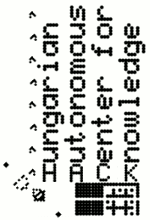Getting the components for the reflowmaster
Most of the parts should be easily accessible at any decent component store, but also rather easily substitutable if neccessary, or if you have something similar on hand. On the list below the first two part will be the trickest; in case of the others a few hints will help you to choose the most suitable for you.
D1:
This is an 1.254 V voltage reference IC masquaraded as a diode. It's accuracy/stability affects the whole temperature control-loop so a rather critical part. LM285-1.2, LM385-1.2, LT1634-1.25. If you can't get the 1.2 V versions, then a 2.5 V one will also do the job, but then you have to double the value of R2.
D5:
KTY84-130. This is a semiconductor based temperature sensor, also a SPOF as I don't know any good substitute for it.
P1:
The most vanilla pin header you can find.
R1-R5:
No special requiments, but 1/8W low tolerance (1%) metal-film types are advised, as not just their values are accurate, but their temperature dependence is also much more lower compared to for example carbon-layer types, which is nice when your circuit works near some heating device :)
The value for R5 depends on the exact type of D4 and U2, but 180 Ohm is a good starting point.
R6:
A regular 1/2 W trough-hole resistor will be OK.
C1-C3:
Creamic types with at least 16V voltage rating will do the job. C1 is optional if the +12V is relatively clean, and the cable lenght to the power source is no more than a few tens of centimeters.
U1:
Technically any dual OPA with the right pinout would suffice, but using a low offset, low noise one with single-ended power supply support will make your life easier. My recommendation was TLC2272 or TLC272, but in practice LM358 turned out to be just as good while being much cheaper.
U2:
Zero-cross switching optocoupler with triac output. Using a random turn-on type will not affect the quality of the reflow process, but puts more stress on U3 and creates EMI on the power network. A lot of type will suffice, but take into account their LED trigger current, when choosing the value for R5.
R5 = (High level voltage of the microcontroller GPIO - (forward voltage drop of D4 + forward voltage drop of U2's LED)) / (LED trigger current of U2's LED)
My recommendation is MOC3063 or TLP3063.
U3:
The tirac will drive a relatively high load and switches high* woltage, so it is adwised to choose it carefully. You need something with 25 A @ 600 V rating pereferably with sensitive gate (few tens of miliampers gate current in all quadrant). My (or actually stef's) weapon of choice is BTA24, wich is a really nice one, it has isolated heatsink, so you won't die in the moment of thouching it, and has high dv/dt and di/dt ratings.
D2:
Any Shottky-diode will do the job.
D3:
Low power 5.6 V Zener-diode.
D4:
Please note that LEDs with different color have different forward voltage drop, which must be taken into account when choosing the value of R5. A few tipical example when using MOC3063 as optotriac:
| Color | Fwd. voltage | R5 value |
| Red | 1.8 V | 100 |
| Green | 2.2 V | 82 |
| Orange | 2.2 V | 82 |
| Blue | 3.3 V | 15 |
